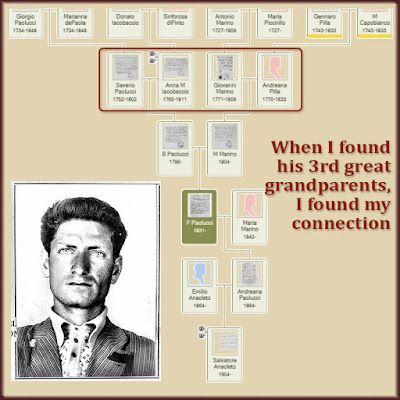You say a public figure has roots in my ancestral town? Challenge accepted!
Let's play a little "Six Degrees of Separation," genealogy style. Can you find your connection to a public figure with roots in the same ancestral town as you?
All my ancestors lived in small, rural Italian hill towns up until 1899–1920. They weren't noblemen, aristocrats, or educated. Their families stayed put for hundreds of years.
Then came a massive exodus of Southern Italian men. Today, descendants of my ancestors' townspeople are spread all over the world. It can be fun to figure out how a public figure connected to your town fits into your family tree.
I've heard that pop star Gwen Stefani and World War II hero "Manila John" Basilone were descendants of my grandfather's Italian hometown.
Tracing the Pop Star
For a long time Gwen Stefani's ancestors were out of my reach. Our connection goes back further than my family tree did. But now my tree has such deep, dense roots in the town of Colle Sannita, that I found our connection.
Here's how I did it. Since she is a public figure, I was able to Google Gwen for her details. Born in 1969 in California to Dennis Stefani and Patricia Flynn. I needed to climb Dennis Stefani's family tree a generation or two to get back to Colle Sannita. I haven't seen the name Stefani in Colle Sannita records. So I expected to find a connection on his mother's side of the family.
I searched for Dennis Stefani and found his mother, born in Michigan, had the maiden name diPaola. That is my hook. That name is significant. I have several direct ancestors from Colle Sannita with that name. They range from a 2nd great grandmother to an 8th great grandfather.
Census records and the marriage record of Dennis Stefani's parents gave me more clues. In America, his mother's parents were Frank diPaola and Lillie Marino. I needed to find Colle Sannita records for a Francesco diPaola and a Libera Marino.
 |
| It takes a pretty big tree to find a place for your celebrity 5th cousin. |
I followed the Francesco diPaola born in Colle Sannita in 1885 across the ocean to America. In 1918, according to his World War I draft registration card, he lived in Michigan with his wife Lilly. The birth date on this draft card confirms that I chose the right birth record from Colle Sannita.
There's more research to do on Libera Antonia (Lilly) Marino, born in Colle in 1888. But so far, her relation to me is only through her husband Francesco diPaola. Francesco's birth record gave me his parents' names. I discovered that his mother's maternal grandparents are my 4th great grandparents.
From my 4th great grandparents, I stepped back down the generations to Gwen Stefani. She and her siblings are my 5th cousins. Her 3 children by one of my favorite rock stars, Gavin Rossdale, are my 5th cousins once removed.
Documenting the War Hero
"Manila John" Basilone was a Congressional Medal of Honor recipient. He died a hero in Iwo Jima, Japan. He showed courage and initiative during a fierce battle and saved the lives of his men.
John has a well-documented life. I learned that his father, Salvatore Basilone, was born in Colle Sannita on Christmas Day, 1884. Salvatore's parents were both named Basilone. His father Angelo was born months after his own father, also Angelo, had died.
Young Angelo Basilone married 3 times between 1858 and 1881. He had children with each wife from 1859 to 1886. As I climbed Angelo's mother's side of the family tree, I connected him to people already related to me.
 |
| I often wonder if Grandpa knew about his sister's in-law, the war hero. |
Giovannangela Iamarino was my Grandpa's sister. Her mother-in-law was Colomba Filomena Pilla. Colomba's grandmother was Colomba Zeolla. Her grandfather was Angelo Mascia. Coming back down, Angelo Mascia's grandson was Salvatore Basilone. He's the father of "Manila John" Basilone. Easy, right?
There is more research to do. I can track down the death records of more of John's ancestors. I may find a closer connection to me. For now, he is in my family tree. He's the 3rd cousin once removed of the husband of my 1st great aunt, Giovannangela Iamarino.
Recently I told you how I fit a stranger with a Brazilian immigration record into my family tree. The theory is the same:
- Start with someone you know has a connection to your ancestral hometown.
- Climb their tree, piecing together as many facts as possible.
- Keep going until you hit one of your relatives.
- Then retrace your steps, adding in all the documents, facts, and sources you used.
Six Degrees of Separation? Six is exactly how many generations I had to climb Gwen Stefani's family tree to hit my direct ancestors. It is a fun game, and we can all use a good distraction right now.









